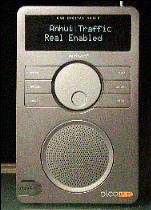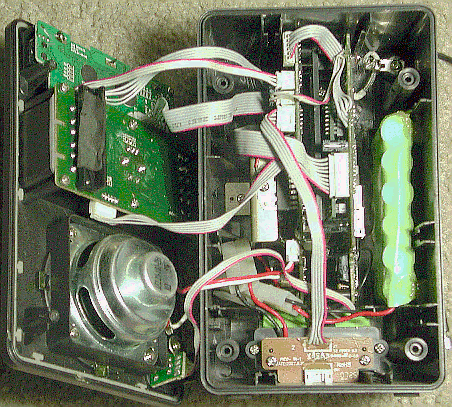Review of the Revo Pico Wi-Fi Radio
Introduction

Listening to Internet radio on a PC is inconvenient. It requires numerous mouse clicks. It ties up your computer and fills your screen with ads, "registration" screens, and animated junk. And it makes you susceptible to viruses and exploitative bandwidth-stealing software. So there's a need for products like the Revo Pico, which make Internet radio as easy and convenient as a regular radio--except you get hundreds of stations and no static. I had high hopes for the Revo Pico. It has some great features, like the ability to listen to propaganda in dozens of different languages and rock music from hundreds of nearly identical FM stations around the globe. It has an attractive design and an easy-to-read, unobtrusive display. If Revo can improve the RF section, computer features, engineering quality, and user interface, future generations of this radio could become a strong competitor with old-fashioned Internet radio as we know it today.
How it works
The Revo Pico is basically a small plastic box designed to look like an ordinary radio, with a speaker in front, a tuning knob, six buttons, and a two-line white backlit dot-matrix LCD display. The heart of the Revo Pico is a Samsung S3C2410AL-20 microcontroller, which is a 32-bit RISC processor capable of running at up to 200 MHz. Inside the plastic box are two small vertically-mounted circuit boards, each with a couple of daughterboards attached. Data are stored in 32M × 8 bit NAND flash memory. The RF section uses a Ralink RT2528L 2.4 GHz transceiver chipset on another small daughterboard that's connected through a USB connector to the main board. The audio section uses a heavily heat-sinked IC. A pack of rechargeable batteries (the seven green blobs at the right and bottom of the photograph below) is glued to the wall of the box.

My first impression on taking this unit apart was that it was a strange combination of hand-assembled stuff mixed in with a few professionally-made PCBs. In places it looks as if someone was having a bad-hair day with their soldering iron. Connectors are mounted crooked, leaded components like capacitors are bent at odd angles, and burned-looking components, frayed wires, bad solder joints, and flimsy connections are everywhere. Yet there are also some sophisticated modern components, like the BGA-format CPU, that require expensive equipment to mount on a board. The unit is made in the UK, where RoHS (Reduction of Hazardous Substances, i.e., lead) is mandatory. The high melting point lead-free solder mandated by the EU might account for the bad soldering. Even so, I considered myself lucky to get the radio back together without any pieces falling off.
Of particular note was the antenna. A wire in the upper right corner of the box leads from the transceiver to a conventional whip antenna like that seen on FM radios. Even when fully collapsed, the antenna is well over a wavelength long. Fully extended, it is way too long for 802.11g frequencies. Inside the box, the signal travels another 3 inches--a huge distance at 2.4 GHz--before reaching the circuit board. This design would create a mismatch that undoubtedly accounts for the poor signal strength and short range of the unit. From my desk, only six feet away from a wireless access point, the signal strength was only 33%. By comparison, a laptop on the next floor gave a reading of 65%. So the Pico needs to be fairly close to a wireless access point.
The front contains a 2¼ inch speaker and a tuning knob. Although a cheap remote control comes with the unit, I found that it was much faster to use the tuning knob than to use the remote. Unfortunately, it's too easy to press down on the tuning knob. Pressing the knob acts like pressing an "Enter" key on a keyboard, and selects the current station or menu item. When this happens, you have to press "Back" and start scrolling through the menu all over again--all the while listening to an unwanted station.
Setup
Setting up the Wi-Fi radio is easy. If you have a DHCP server running (as most people do if they have a wireless router), it will automatically grab an IP address and connect. It can also be configured to take a static IP, but only through the front panel; there is no Web interface. It takes WEP and WPA. Only 802.11b and g are supported (no a or n). Once you enter your WPA key (a laborious process that involves rotating the dial and pressing "Select" to enter each digit), it automatically finds your network and connects. Note that this means that if you move the radio to some other network, you have to go through the laborious process of entering a new key. However, once a key has been entered, it is automatically remembered. Once connected, it then connects to Revo's server and you can start downloading lists of stations to scroll through.
It can also receive regular broadcast FM (tunable from 87.5-108.0 in 0.05 MHz increments). The FM radio is less sensitive than my other radios and only the strongest stations could be heard. The sound blanks out when tuning.
Another feature is the ability to play back audio files from a networked Windows or Mac OSX computer. When you select this option, the Revo will present a list of files in shared directories. It knows SMB/CIFS, AppleTalk, SLP, and LDAPv3. It can read the following file formats: AAC, AIFF, AU, MP3, RM, WAV, and WMA. So, in principle, if there were some way of creating a FIFO (called a 'named pipe' in Windows), you could send any audio stream, such as from a CD or media player, to the Pico. Creating a FIFO and redirecting a data stream to it are easy in Linux, but based on my limited knowledge of Windows, it may not be possible in Windows without special software.
Stations
The station list is limited to whatever is on a central website. This points out the biggest problem with this radio: if, heaven forbid, this website disappears, your radio sooner or later will become a 300 dollar brick. Stations can be selected by genre or location. Most of these are rock and pop music stations, along with a large number of talk stations. By far the greatest number of stations are commercial FM stations, such as KBSU-FM 90.3 (a classical music station in Boise, Idaho). That means the variety of music types is much smaller than you would find at an Internet radio source like Live365. There are also a handful of bluegrass, indie, techno-rock, folk, and easy listening stations. Many of these are misclassified in their genre list; for example, some 'rock' stations are misclassified as bluegrass, and some stations that can only be described as 'mush' are misclassified as classical. There are also some unusual stations, like NASA's online VLF receiver and several Chinese-language talk stations, such as Anhui Traffic Radio from Mainland China (update: since this page was created, the NASA VLF site has disappeared). There is no way to add stations on your own. Although it's possible to send in requests for new stations to be added, the requests seem to be ignored. About 3/4 of the stations in their list seem to be real; the rest of them just hang while the two-line display says "Connecting..."
It is possible to store up to five presets using the remote control. There is no mute button. The radio sometimes gets stuck in a mode from which it can't connect to anything, and the only way to fix is to power cycle and start over. Every time you turn on the radio, it takes about 30-60 seconds to find the network. It then automatically re-connects to whatever you were listening to before. For some stations, the sound is typical of low bitrate audio, with the usual dropouts and distortions, while some others are better, with bitrates as high as 128 kbps. There's a headphone jack in back, which produces okay-sounding stereo sound.
Conclusion
Although it's a great idea and a likeable, compact design, this radio is too inflexible to be worth the $300 they're charging for it. I still believe Wi-Fi is the radio of the future. Wi-Fi radio will most likely kill off what's left of terrestrial broadcast radio (unless the record industry manages to bribe enough congressmen to kill off Internet radio first). However, the technology is not quite there yet. If you need wireless, and don't mind watching animated Javascript advertisements on your computer, you might be better off getting one of those old 900 MHz or 2.4 GHz wireless transmitter/receiver combinations for about one-fourth the price. On the other hand, this compact unit won't take up much space on your desk, and unlike a Windows computer, it will never get viruses or start spewing out packets on your network.
back
